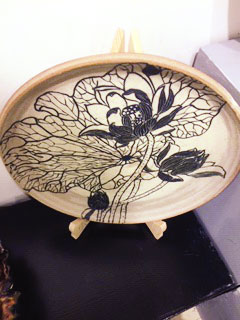According to U. Nair, The All India Studio Pottery Exhibition showcased stoneware and ceramic niceties ranging from humble pots to platters and a few items of sculpture.
Four galleries full of stoneware and ceramic niceties that stemmed from humble pots to platters and a few items of sculpture. The All India Studio Pottery Exhibition 2019, presented by the AIFACS and Delhi Blue Pottery Trust was a treat for tired eyes. There seemed to be more work in stoneware, you could not help but stand and gaze quietly at the buff shades that is soothing to the sight.
Stoneware Sheep
It is called stoneware due to its dense and stone-like character. After being fired, this type is impermeable (waterproof) and usually opaque. In its natural state, stoneware clay is grey but the process of firing turns it into light-brown or buff coloured, and different hues may then be applied in the form of glazes. Generally speaking, stonewares are fired at temperature between 1,100-1,300 degree celsius.
And so back to the most loved pieces for this critic. On top of my list is Chitra Sharma and her small quaint sheep, hand-moulded and curious in terms of the many details and the impeccable nature of her composition. Small and immaculately thrown, the viewer is mesmerised by the soft transparent glaze that has strips of various lengths ringing the sheep’s bodies. They have a Biblical perfection and are born of a different spirit, and one readily reckons that she must be discovered in depth of details and compositions; pieces like this are incredibly hard to fire, as all kinds of accidents can occur in the kiln like cracking, warping and running of glazes, but here were four sheep that alluded all kinds of parts and places including the snow-filled mountain tops.
Two platters
There were a number of platters on view too, but it was that of of Archana Singh and Bipasha Sengupta that stood out for their simplicity and patterns of both minimalist moorings as well as the eternal lotus leaves. Archana’s deft architectural drawing done by ceramic pencil on stoneware, high fired at 1,280 degree celsius, and was finished with a transparent glaze. It was softly stirring to the senses while Bipasha Sengupta’s stoneware platter with resplendent lotus leaves and flowers done as an outline in black slip with transparent glaze spoke at once of the spiritual fervour and the pensive beauty of the lotus leaves that have always been a subject of great interest and intrigue to artists of different mediums.
Man and nature
If there was a well-crafted, calculated work, it was that of Aarti Paliwal. Likewise, as a represented ceramicist she is highly skilled, and reflects a certain sophistication in her cup that speaks of man and nature. Each detail that she evokes in her pieces is sheer perfection. This being so, there are a few signs of the ecological aesthetic that regards such ‘flaws’ as stone bursts, cracked lips and unevenness as part of the beauty of imperfection in her magnificent cup and saucer.
“My ceramic work is inspired by humans, natural forms and textures — trees, rocks, mushrooms, the human figure, modern surfaces and the fusion of traces of human activity in relation to nature,” Paliwal explains. “I see my work as a personal journey exploring identity, connecting to roots and expressing the process of evolution and the layering of human destruction that makes up a whole. My forms are a reflection of man’s relationship with natural forms. What attracts me to the universal world is the changes that happen; it is as if we are looking at differing life forms and how we impact nature in a destructive way.”
Bird heads as a subject
Anjali Jaggi’s rooster heads, done in transparent glaze with red slip, were a candid stoneware set that also spoke of the spirit as well as the technique. It is an inspiration that hold’s one attention. Not all the works were worthy of scrutiny or intensity. Whatever the cause of the exclamations, whether a neatly turned bowl or a sculptural entity, what entices is the endearing quality of ceramics and stoneware.
Lively visuals
There were lively visuals of decorative ceramic artworks, and a myriad of colours and designs that would tingle your senses. Among the simpler creations, one work was Manoj Kumar’s small fish, made of stoneware and high fired in transparent glaze with red and black slip. The small plate held its own because it ascertained to the truth that this is a highly expressive way of working and at its most basic relies solely on the hands as tools. On display one saw a varied working range, from intricate and intimate processes to a whole body experience.
Stoneware varies greatly in scale and style: from figurines delicately modelled with thumb and forefinger in the palm of the artist’s hand, to vigorous works produced by hurling wet clay at a structure to build up form, and everything in between. Creating with clay can be fast and immediate, also small and expressive, conjuring up images of the first figures of ancient times, whose features were squeezed out of wet clay to resemble animals and human forms.
In subtle and varied hues this was an exhibition that showed deft handling and unending passion and one must remember yeoman’s service done by Ravi and Leena Batra for the inspiration and infrastructure that Delhi Blue pottery provides potters of all ages.
Writer: Uma Nair
Courtesy: The Pioneer








 OpinionExpress.In
OpinionExpress.In















Comments (0)